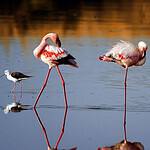Table of Contents
Kilimanjaro’s 2025 Wildlife Forecast: What to See and When on the Mountain
Kilimanjaro Wildlife Forecast 2025
offers an exciting opportunity to explore the unique ecosystems of Africa’s highest peak. Mount Kilimanjaro is not only the tallest mountain in Africa but also a varied ecosystem home to diverse and rare wildlife. Kilimanjaro Wildlife Forecast 2025 provides insights into the mountain’s different habitats, offering exceptional opportunities for spotting unique species found nowhere else in the world. In this Kilimanjaro Wildlife Forecast 2025, we will guide you through various ecological zones and highlight when and where to spot incredible wildlife during your adventure.
Overview of Kilimanjaro’s Ecological Zones and Wildlife
Mount Kilimanjaro has five distinct climate zones: cultivation, rainforest, heath, alpine desert, and summit-each with a host of species that have adapted to life within their respective environments. From lush rainforests at the lower elevations to the desolate summit, this mountain’s flora and fauna are both varied and surprising. Herein is a breakdown of what to look out for in each zone:
- Cultivation Zone (800 – 1,800 meters)
- Rainforest Zone (1,800 – 2,800 meters)
- Heath and Moorland Zone (2,800 – 4,000 meters)
- Alpine Desert Zone (4,000 – 5,000 meters)
- Summit Zone (5,000 meters and above)
Cultivation Zone (800 – 1,800 meters)
Overview: It is the lowest of Kilimanjaro’s ecological zones, most of the landscape in this zone having been converted into farmland. Even though there is hardly any chance of sighting any game in this area because of human interference, this area showcases glimpses of local agriculture and some adaptable species.
Wildlife Highlights include:
- African Olive Pigeon and Montane White-eye: Both these bird species are seen to visit this place rather frequently for feeding on the crops and vegetation grown here locally.
- Blue Monkey: These are very inquisitive monkeys; hence, they are found to roam in groups, close to the periphery of the forest, feeding on fruits and leaves.
Best Time to Spot: March to June. March to June. These species are more visible in the wet season when food is plentiful and animals frequent the edges of forests.
Rainforest Zone (1,800 – 2,800 meters)
Overview: The rainforest is the most biodiverse zone on Kilimanjaro. Dense with tropical foliage and a misty canopy, this zone shelters numerous mammals, reptiles, and bird species.
Wildlife Highlights:
- Colobus Monkeys: With their striking black-and-white fur, colobus monkeys are seen quite often while on treetops. Because of the very social behavior and calls of these particular monkeys, they are always noticed.
- Aardvark: Highly seldom to be seen and largely secretive, aardvarks have nevertheless occurred burrowing in the dirt during some nighttime ascents.
- Leopard (rare): Elusive but recognized and frequently documented to occur well within the rainforest, leopards are an infrequent sight; when they appear, it can be thrilling.
- Abbot’s Starling: The Abbot’s Starling is highly localized to this area and often can be seen perched atop the treetops.
Best Time to Spot: March to May and October to December. from March to May and from October to December. During rainy seasons, colobus monkeys and birds are most active. During early mornings, this is the best time when animals go out to look for food.
Heath and Moorland Zone (2,800 – 4,000 meters)
Overview: As climbers gain height, they reach heath and moorland characterized by giant heathers and openness. The landscape is a host to uniquely adapted wildlife, which comprises some endemic species.
Wildlife Highlights:
- Four-Striped Grass Mouse: These are small mammals that you may always see when promulgating around the vegetation of the moorland
- Jackson’s Chameleon: These chameleons sport bright colors with three structures that are horn-like, which can often be seen on plants and trees.
- Alpine Chat: Little endemic bird, inhabiting at an altitude of higher than 2,000 meters. Alpine Chat is usually seen sitting on shrubs and top rocks.
Best Time to Spot: June to September. June to September. Viewing reptiles is best during the dry season; the sun draws them out. Best time for birds: also early mornings and late evenings, especially birds like Alpine Chat.
Alpine Desert Zone (4,000 – 5,000 meters)
Overview: The extreme conditions in the Alpine Desert Zone, low oxygen, freezing temperatures, and little water support very few living organisms. But the endemics found on Kilimanjaro have adapted to survive on this desolate landscape.
Wildlife Highlights:
- Mount Kilimanjaro Mole Rat: Being an endemic species, the Kilimanjaro mole rat is highly adapted to burrowing in rocky ground. It is often seen in small groups.
- Malachite Sunbird: Less common at high altitude, these brilliant green birds feeding on the flowers in the moorland.
Best Time to Spot: January to February and August to October. January to February and August to October. During the drier months of the year, it’s much easier to manage to spot mole rats since these conditions force them to be more active above ground.
Summit Zone (5,000 meters and above)
Overview: The summit zone, a harsh, arctic landscape, is nearly void of life. Here, temperatures can plunge to -20°C, and oxygen levels are drastically reduced. Despite the extreme conditions, a few hardy species occasionally make appearances.
Wildlife Highlights:
- Lichen and Mosses: While not animals, these resilient plants are fascinating to observe as some of the only life forms that can endure this extreme climate.
- Migrating Birds: Occasionally, migrating birds can be seen passing through, but they’re rare.
Best Time to Spot: Year-Round. Due to the limited and sparse nature of life in this zone, sightings are purely by chance.
Seasonal Wildlife Forecast for 2025
Although it is possible to visit throughout the year, Kilimanjaro’s wildlife activities vary with the seasons. Here is an overview of the Kilimanjaro seasonal wildlife forecast for 2025:
- January to February (Short Dry Season): This is considered the best time to view small mammals and bird species that may exist in the moorland and alpine zones. Due to less rain, it is pretty excellent for bird watching because the skies are clear, which means less rain impeding visibility.
- March to May (Long Rainy Season): This is the long rain season, and it is also the period with the highest activity in the rainforest zone. Monkeys, aardvarks, and endemic birds will be most active during these wet months. Lush greenery will make an awesome backdrop to their display. This gives fantastic opportunities for wildlife photographers who are prepared to brave the rains.
- June to September (Long Dry Season): Peak climbing season, so there are lesser chances of rain. Reptiles like chameleons are visible since they bask in the sun. It is easy to see wildlife, especially near a water source since animals come to quench their thirst.
- October to December (Short Rainy Season): This is typically the most alive season for rainforests. This is a good time to see colobus monkeys, birds, and insects that thrive in these moist environments. Occasional rain creates lush green landscapes but doesn’t impede visibility much.
Tips for Wildlife Spotting on Kilimanjaro
- Hire Knowledgeable Guides A professional guide would be able to locate species based on their calls or tracks, and this also ensures that you encounter the shyer animals with greater ease.
- Carry Binoculars: This is a very handy device in bird-watching and animal observation from afar.
- Start Early: Most animals are active during the morning hours of dawn; therefore, you should also start your hike early to enhance your spotting chances.
- Pay Attention to Noise Levels and Move Slowly: The most basic disturbance to wildlife comes from loud noise levels. Moving quietly will bring you closer to viewing animals.
- Respect Wildlife and Maintain Distance: Not only for your protection, but also out of respect and concern for the animals’ well-being, keep a respectful distance, particularly from larger mammals.
Conclusion
Kilimanjaro Wildlife Forecast 2025 unveils the fascinating array of species that inhabit this iconic mountain. From the inquisitive blue monkeys of the rainforest to the rare mole rats of the alpine desert, and even the soaring alpine chats, Kilimanjaro Wildlife Forecast 2025 highlights the incredible biodiversity across all ecological zones. Each species on Kilimanjaro plays a crucial role in maintaining the balance of its unique ecosystem.
Using this Kilimanjaro Wildlife Forecast 2025, climbers can enrich their journey by learning about the diverse habitats and seasonal wildlife activity. The Kilimanjaro Wildlife Forecast 2025 provides insights into the best times and locations to spot rare animals and birds, ensuring an unforgettable experience. Whether it’s observing the colobus monkeys in the rainforest or discovering the elusive creatures of the moorland, Kilimanjaro Wildlife Forecast 2025 guides you every step of the way.
For wildlife enthusiasts, the Kilimanjaro Wildlife Forecast 2025 serves as a detailed resource to maximize wildlife sightings and deepen their appreciation of Kilimanjaro’s natural beauty. With the Kilimanjaro Wildlife Forecast 2025, you’ll understand the intricate connections between the mountain’s flora and fauna, enriching your trek with meaningful encounters.
Plan your adventure with the Kilimanjaro Wildlife Forecast 2025 to unlock the secrets of the mountain’s vibrant ecosystems. The Kilimanjaro Wildlife Forecast 2025 ensures climbers have the information they need to respect and observe wildlife responsibly, creating memories that last a lifetime. Don’t miss the chance to explore Kilimanjaro’s unique habitats with the help of the Kilimanjaro Wildlife Forecast 2025!
By following the guidance of the Kilimanjaro Wildlife Forecast 2025, climbers can witness the natural wonders of this majestic peak. Let the Kilimanjaro Wildlife Forecast 2025 be your ultimate companion for understanding the beauty and complexity of Kilimanjaro’s environment.
With the Kilimanjaro Wildlife Forecast 2025, your adventure will transcend the climb itself, immersing you in the extraordinary biodiversity of Africa’s tallest mountain. Make the Kilimanjaro Wildlife Forecast 2025 your go-to guide for a truly unforgettable journey.

















